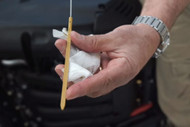How to Check Your Four-Stroke Outboard Engine Oil
Checking the oil level in a four-stroke outboard is about as basic as maintenance gets, and should be part of the “pre-flight” routine of every outboard owner. But I’m guessing many outboard owners go an entire season without lifting the cowl, because our boats–like our road vehicles–are so reliable and maintenance-free these days that we don’t give much thought to oil and filters. My truck has 200,000 miles on the clock and still goes 7,500 more between oil changes without using a drop of lube. So I don’t check it often. As we hear from Yamaha expert David Meeler, however, you should put an eyeball on the dipstick every time you use your boat.
More outboard owners would check the oil level if the cowl was easier to remove. Lifting the lid on a big V6 can take muscle and agility, especially if the boat’s in the water. How about a little hatch in the cowl to access the dipstick? I should patent that idea.
Another benefit of removing the cowl for a routine oil level check is that you’ll have a chance to examine the powerhead for other issues, such as a fuel leak, a blossom of corrosion, or loose battery connections. Consult your outboard owner’s manual (which I hope you’ve read, or at least saved somewhere) for the exact oil check routine for your motor, because each brand and model is a little different. For example, you’ll want to check Mercury FourStroke 115 oil level with the engine cool, but a Yamaha 115 should be at operating temperature before you check the oil. Pay special attention for instructions on how to read the dipstick. As Meeler walked us through the procedure for a Yamaha V6 outboard, he pointed out that the correct oil level for this motor is half-way up the cross-hatch pattern on the stick. If your oil is low, add a little at a time until the level is in the middle of the cross-hatch.
Meeler also said that the motor’s orientation is critical. If the boat is on a trailer, put a carpenter’s level on the anti-ventilation plate and adjust the trim until the plate is horizontal to the ground. Because a Yamaha outboard oil sump is cone-shaped, just a little angle to the motor magnifies the actual oil-level reading on the dipstick, which is why that cross-hatch on the dipstick is so wide – it’s designed to give you some leeway. Details like this will be explained in your outboard owner’s manual.
Posted by Ivan Drago


